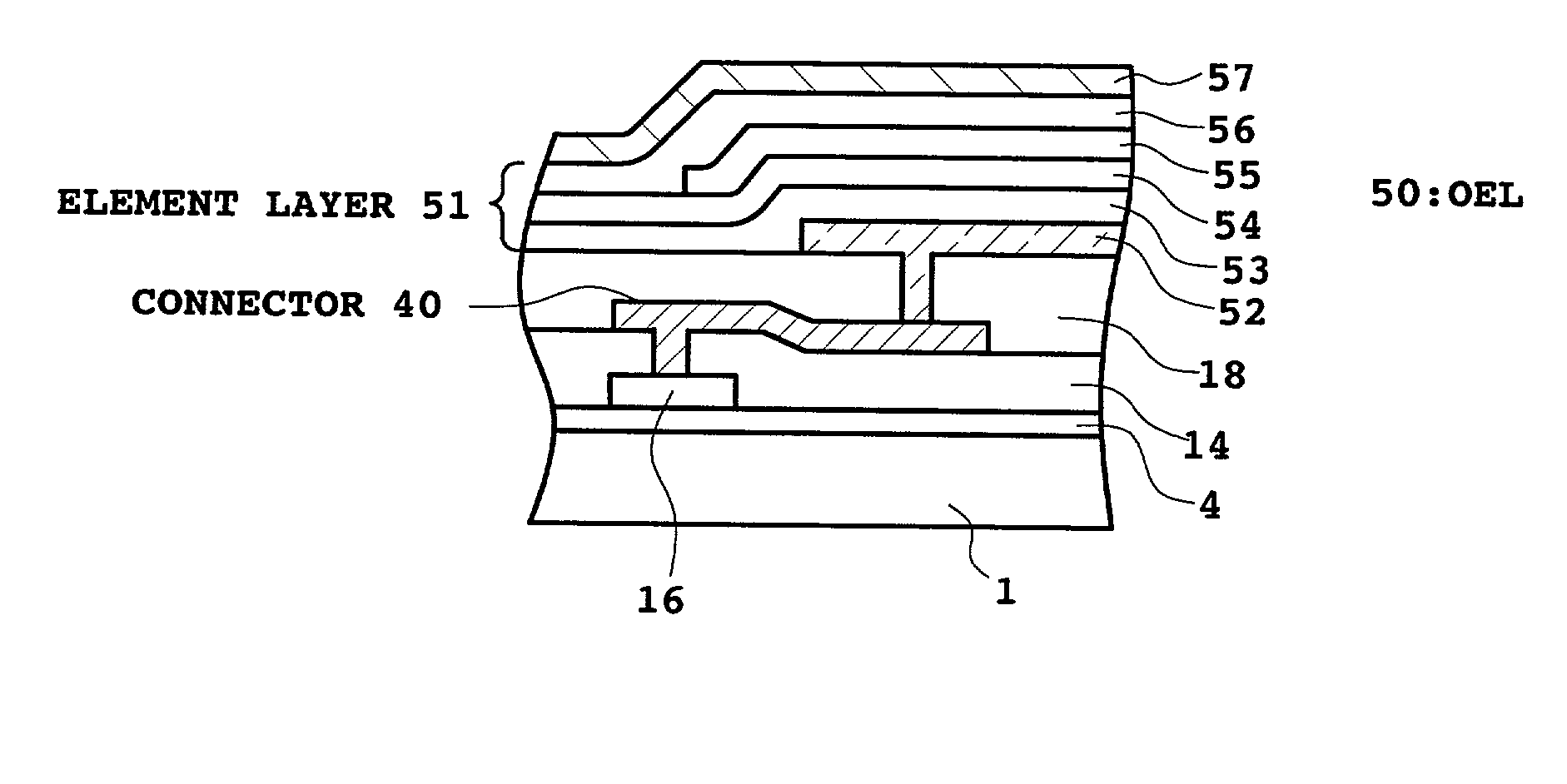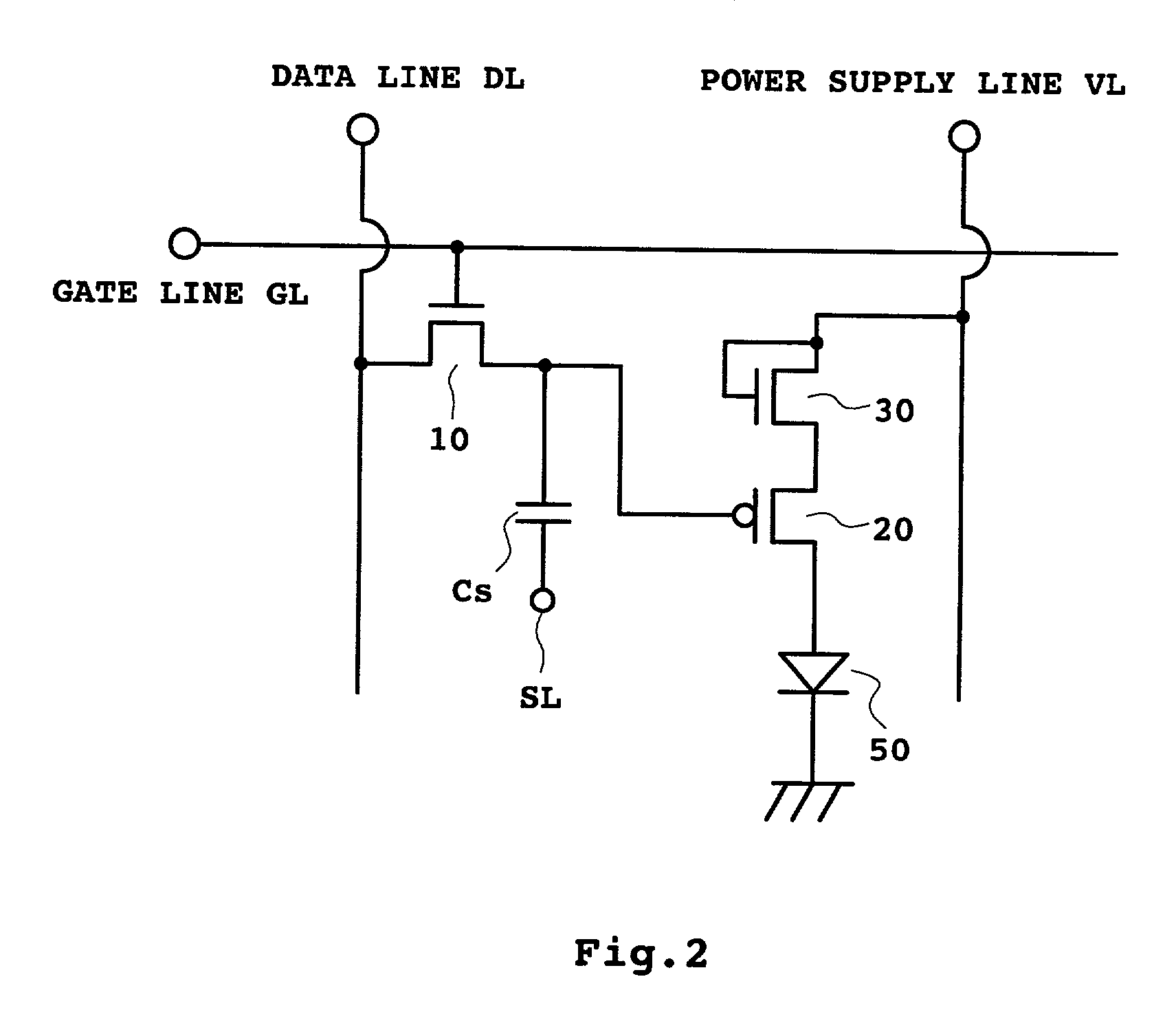Contact between element to be driven and thin film transistor for supplying power to element to be driven
a technology of thin film transistor and contact between elements, which is applied in the direction of luminescent display devices, identification means, instruments, etc., can solve the problems of uneven grain size of polycrystalline silicon, on-current characteristic or the like of tft, and other problems
- Summary
- Abstract
- Description
- Claims
- Application Information
AI Technical Summary
Benefits of technology
Problems solved by technology
Method used
Image
Examples
first embodiment
[0040] First Embodiment
[0041] FIG. 2 shows a circuit structure of one pixel in an active matrix type EL display device having m rows and n columns according to a first embodiment of the present invention. As shown in FIG. 2, each pixel comprises an organic EL element 50, a switching TFT (first TFT) 10, an element driving TFT (second TFT) 20, and an storage capacitor Cs, and is constructed in a region surrounded by a gate line GL extending in the row direction and a data line DL extending in the column direction. In the first embodiment, a compensation TFT 30 having the conductive characteristic opposite of that of the second TFT 20 is provided between the power supply line VL and the second TFT 20. The gate and either the source or the drain of the compensation TFT 30 are connected to provide a diode connection. The diode is connected in the forward direction between the power supply line VL and the second TFT 20. Thus, the compensation TFT can be operated without supplying any desi...
second embodiment
[0071] Second Embodiment
[0072] A second embodiment of the present invention will now be described. In the first embodiment, in order to prevent variation in the illumination brightness among pixels as a result of characteristic variations in the transistor, a compensation thin film transistor having an opposite conductive characteristic as the element driving thin film transistor is provided. In contrast, in the second embodiment, the variation in the illumination brightness among pixels is inhibited by considering the placement of the element driving thin film transistor (second TFT). FIGS. 10A and 10B show an example configuration of one pixel according to the second embodiment. FIG. 10A is a schematic planer view and FIG. 10B is a cross sectional view along the B-B line in FIG. 10A. This structure is shown with the same circuit structure as that of FIG. 1. In these figures, the components corresponding to those in the drawings that are already explained will be referred to by the...
third embodiment
[0090] Third Embodiment
[0091] A method for efficiently connecting a plurality of second TFTs 20 and corresponding organic EL element 50 within one pixel will now be described as a third embodiment of the present invention. As described in the first embodiment and as shown in FIG. 11 of the second embodiment, provision of a plurality of second TFTs 20 between an organic EL element 50 and a power supply line VL within one pixel is advantageous from the viewpoint of improvements in reliability, characteristic, or the like. In a case wherein a plurality of second TFTs 20 are provided within one pixel, as shown in FIG. 11, by respectively connecting the second TFTs 20a and 20b and the organic EL element 50, a current can more reliably be supplied from the power supply line VL to the organic EL element 50 via the second TFTs 20. However, in an organic EL element of the type shown in FIG. 10B in which light from the emissive layer 55 is emitted from a transparent anode 52 to the outside vi...
PUM
 Login to View More
Login to View More Abstract
Description
Claims
Application Information
 Login to View More
Login to View More - R&D
- Intellectual Property
- Life Sciences
- Materials
- Tech Scout
- Unparalleled Data Quality
- Higher Quality Content
- 60% Fewer Hallucinations
Browse by: Latest US Patents, China's latest patents, Technical Efficacy Thesaurus, Application Domain, Technology Topic, Popular Technical Reports.
© 2025 PatSnap. All rights reserved.Legal|Privacy policy|Modern Slavery Act Transparency Statement|Sitemap|About US| Contact US: help@patsnap.com



